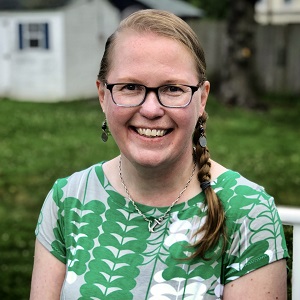
Your Very Eyes
Contributor’s Marginalia: Maureen Thorson responding to Gail Griffin’s poem “Geographic Atrophy”
Illness of any kind occurs in a body. Within bodies (or above, around, and through them) lurk minds. But any suffering mind seeking to express the condition of being ill is confronted with what Virginia Woolf calls the “poverty of the language” of illness. Someone in love or beset by grief can call upon a hundred novels, operas, and poems to focus and magnify that experience. But while illness has certainly been written about, its most common medium is memoir. The first-person, factual nature of such accounts reinscribes the notion that illness is essentially solitary, a weakness that is less shared than confessed.
In her poem, “Geographic Atrophy,” Gail Griffin attempts to bridge this divide while acknowledging illness’s lonely experiential quality. Written in the second person, the poem refuses the reader the distance of a narrating “I.” Instead, the reader becomes the subject of the poem’s governing metaphor—a castaway on a desert island, set apart from society. But while the reader may presently be the sole person “tossed by fate” upon the island, they are not the first person to find their way there. The island’s “lonely shore” is fitted with reminders of past inhabitants: “a reef where many a vessel has burst,” a cove named “for the one who dwelt there alone,” and “Abandoned / caves holding traces of old fires.”
Griffin gives her castaway reader/subject a map, but that’s a doubtful solace. First described as an “escape map,” and later as a treasure map, it finally winds up as a “map of nothing.” The map’s final form recalls the poem’s title, “geographic atrophy.” Not just a curious phrase, “geographic atrophy” is an acute form of macular degeneration in which the retina is pocked with dead regions that, as the poem’s epigraph explains, can “look like a map to doctors.” But the fact that something looks like a map—with “forests, high rocks, trails,” and “an X of crossed bones”—is not the same as its being helpful for finding anything. The “map” that geographic atrophy provides is a symbol of nothing, just the chancy arrangement of the dead spots that characterize the condition. In the face of the reality of illness, metaphor breaks down. The map is the territory, and the territory is “vanishing before your very eyes.”
Within the poem, of course, the map is a metaphor, and a heartbreaking one at that. A map that shows the way to “escape” is clearly a hopeful image. A treasure map, too—a way to find what has been carefully saved. But in the poem’s last few lines, the “only X is the one at your feet / that says YOU ARE HERE.” The grim joke of declaring “YOU ARE HERE” in the middle of nowhere is that “here” only makes sense in contrast to a knowable “there.” Just so, “you” is a sensible concept only in relation to selves that are not “you.” But for the reader-as-sufferer in “Geographic Atrophy,” every point of reference, every contextualizing framework, is on the brink of disappearing. That estrangement from the known and knowable is terrible, just as a condition that inflicts blindness is not something that can be tidied away with words.
As Woolf indicates, this is one reason that illness is lonely; it is too real for the inexactitude of language, one of our primary means for maintaining a sense of shared reality. At the same time that illness reveals the poverty of the sufferer’s tools for expression, it fails to extinguish the sufferer’s need to understand themselves and be understood by others. Through its sinuous metaphor of the lonely castaway and their disappearing map, “Geographic Atrophy” simultaneously acknowledges the impossibility of the task and the need to attempt it.
